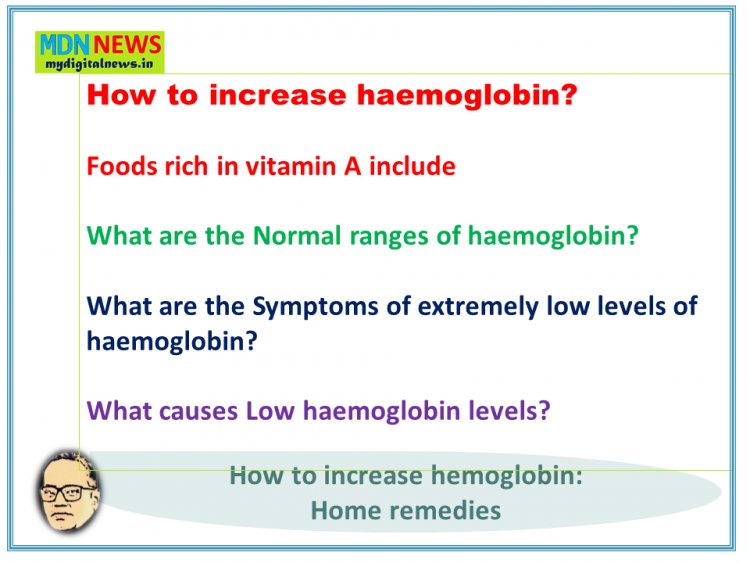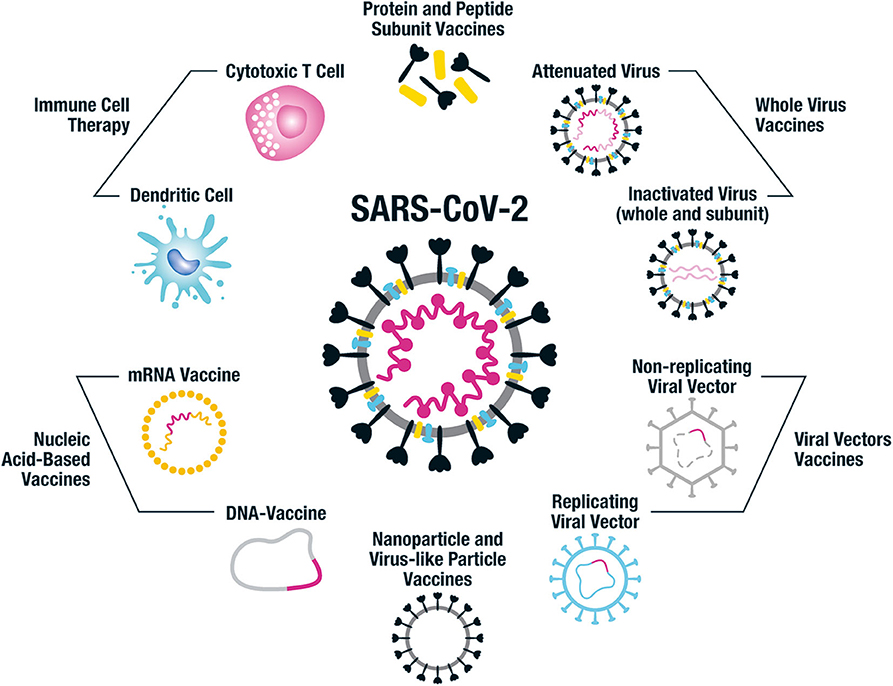How to increase haemoglobin at home Naturally?
{For informational purposes only. Consult your local medical authority for advice...} Hemoglobin is an important component of red blood cells. Pregnancy may cause low hemoglobin levels. Eating iron-rich foods may help prevent low hemoglobin levels.

Foods rich in vitamin A include
What are the Normal ranges of haemoglobin?
What are the Symptoms of extremely low levels of haemoglobin?
What causes Low haemoglobin levels?
In addition to transporting oxygen, haemoglobin carries carbon dioxide out of the cells and into the lungs. Carbon dioxide is then released as a person exhales. Having low haemoglobin can make it difficult for the body to perform these functions. In this article, learn how to increase haemoglobin levels naturally. We also look at methods of testing and what the results show. Haemoglobin is a protein found in red blood cells. These cells are responsible for carrying oxygen around the body.
How to increase haemoglobin
A person can raise their haemoglobin levels at home by:
1. Increasing iron intake
A person with reduced levels of haemoglobin may benefit from eating more iron-rich foods. Ironworks boost the production of haemoglobin, which also helps to form more red blood cells.
Iron-rich foods include:
- meat and fish
- soy products, including tofu and edamame
- eggs
- dried fruits, such as dates and figs
- broccoli
- green leafy vegetables, such as kale and spinach
- green beans
- nuts and seeds
- peanut butter
2. Increasing folate intake
Folate is a type of vitamin B that plays an essential part in haemoglobin production. The body uses folate to produce heme, a component of haemoglobin that helps to carry oxygen. If a person does not get enough folate their red blood cells will not be able to mature, which could lead to folate-deficiency anaemia and low haemoglobin levels.
Good sources of folate include:
- beef
- spinach
- rice
- peanuts
- black-eyed peas
- kidney beans
- avocadoes
- lettuce
3. Maximizing iron absorption
Consuming iron in foods or supplements is important, but a person should also help their body to absorb that iron. Foods rich in vitamin C, such as citrus fruits, strawberries, and leafy green vegetables, can boost the amount of iron absorbed. Taking a vitamin C supplement may also help. Vitamin A and beta-carotene can aid the body in absorbing and using an iron.
Foods rich in vitamin A include:
- fish
- liver
- squash
- sweet potatoes
- kale and collards
Foods high in beta-carotene include yellow, red, and orange fruits and vegetables, such as:
- carrots
- sweet potatoes
- squash
- cantaloupes
- mangoes
While vitamin A supplements can help the body to process iron, the vitamin is dangerous if too much is consumed. Excess vitamin A may lead to a condition known as hypervitaminosis A. This can cause symptoms such as bone and joint pain, severe headaches, and increased pressure within the brain.
4. Taking iron supplements
A doctor may advise a person with extremely low levels of haemoglobin to take iron supplements. The dosage will depend on a person’s levels. It is important to note that too much iron can be dangerous. It may cause hemochromatosis, which can lead to liver disease and side effects such as constipation, nausea, and vomiting. Supplements will cause levels of iron to increase gradually over a few weeks. A doctor may recommend taking the supplements for several months, to increase the body’s iron stores.
Normal ranges of haemoglobin
A doctor will check for low haemoglobin with a blood test. Low haemoglobin is diagnosed when a man has less than 13.5 grams per deciliter (g/dL) of haemoglobin in the blood, or when a woman has less than 12 g/dL. A person may have a low haemoglobin level for a variety of reasons, including:
- iron-deficiency anaemia
- pregnancy
- problems with the liver or kidneys
- chronic disease
It is possible to have naturally reduced haemoglobin levels without an underlying cause. Some may even have low haemoglobin and experience no symptoms or indications. With a doctor’s guidance, a person can boost their levels of haemoglobin to fall within a normal range. Normal ranges are: 13.5 to 17.5 g/dL for men . 12 to 15.5 g/dL for women . Appropriate haemoglobin levels for children vary depending on age. Anyone concerned about a child’s haemoglobin levels should speak with a doctor. People with very low haemoglobin levels may need additional treatment if taking supplements and changing the diet do not show sufficient results. Symptoms
Symptoms of extremely low levels of haemoglobin include:
- a fast or irregular heartbeat
- pale skin and gums
- fatigue
- muscle weakness
- frequent or unexplained bruising
- reoccurring headaches
Causes of low haemoglobin
A person with low haemoglobin may have anaemia. Common causes of anaemia include:
- being deficient in iron, vitamin B-12, or folate
- substantial blood loss
- cancers that affect the bone marrow, such as leukaemia
- kidney disease
- liver disease
- hypothyroidism, or a thyroid gland that does not produce enough hormones
- thalassemia, a hereditary disease that prevents haemoglobin from functioning properly
- sickle cell anaemia, a genetic disorder that causes a reduction in red blood cells and haemoglobin
Low haemoglobin levels can also be caused by:
- lung disease
- excessive smoking
- burns
- extreme physical exercise
Many people can boost their haemoglobin levels with dietary changes and supplements. Speak with a doctor to determine the correct supplement dosage. If haemoglobin levels remain low, a person may need further treatment, such as a blood transfusion. Depending on the cause of low haemoglobin and the treatments attempted, it may take up to a year for levels to reach a healthy range.
Note: this article is and the information and information provided in this article are based on general information. and it is not suitable for everyone, and neither MDN NEWS, mydigitalnews.in. nor its team does not confirm these. Please contact the relevant expert, or doctor before implementing them.)
గమనిక: ఈ వ్యాసం మరియు ఈ వ్యాసంలో అందించిన సమాచారం , సాధారణ సమాచారం మీద ఆధారపడి ఉంటాయి. మరియు ఇది అందరికీ అనుకూలంగా ఉండదు మరియు MDN NEWS, mydigitalnews.in. లేదా దాని బృందం వీటిని నిర్ధారించదు. దయచేసి వాటిని అమలు చేయడానికి ముందు సంబంధిత నిపుణుడిని లేదా వైద్యుడిని సంప్రదించండి.)
What's Your Reaction?










































































